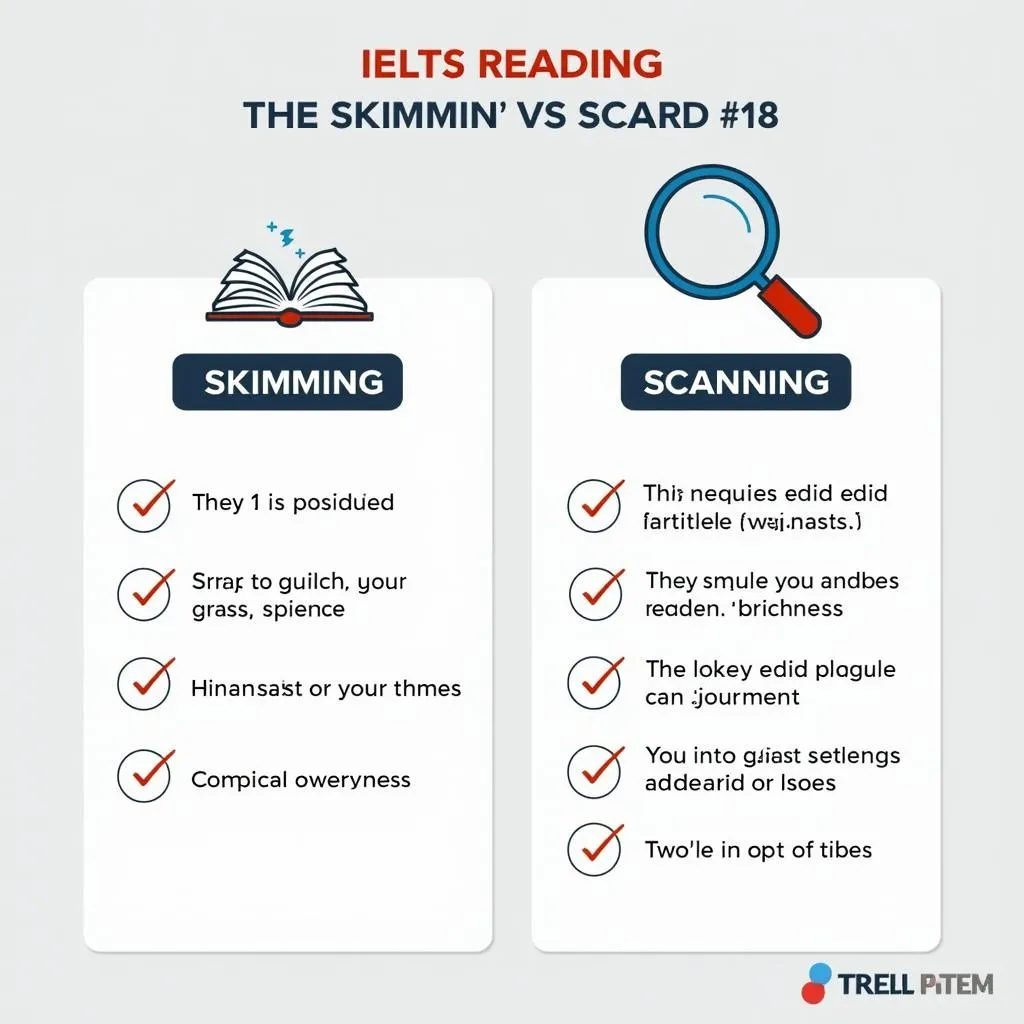Understanding Skimming and Scanning in IELTS Reading
Skimming and scanning are two essential techniques that can significantly improve your performance in the IELTS Reading test. These skills allow you to quickly find specific information and get a general idea of the text, saving valuable time during the exam.
Table Of Contents
- Understanding Skimming and Scanning in IELTS Reading
- What is Skimming?
- What is Scanning?
- Skimming Examples in IELTS Reading
- Example 1: Understanding the Main Idea
- Example 2: Identifying Text Structure
- Scanning Examples in IELTS Reading
- Example 1: Finding Specific Information
- Example 2: Locating Names or Dates
- Combining Skimming and Scanning for IELTS Success
- Practice Exercise
- Key Takeaways for Skimming and Scanning in IELTS Reading
What is Skimming?
Skimming involves quickly reading through a text to get a general understanding of its main ideas. This technique is useful for answering questions about the overall theme or purpose of a passage.
What is Scanning?
Scanning is the process of quickly searching for specific information within a text, such as dates, names, or figures. This technique is particularly helpful when answering detail-oriented questions.

Skimming Examples in IELTS Reading
Let’s look at some practical examples of how to apply skimming in IELTS Reading:
Example 1: Understanding the Main Idea
Consider this excerpt from an IELTS Reading passage:
“The Great Barrier Reef, stretching over 2,300 kilometers along the northeast coast of Australia, is the world’s largest coral reef ecosystem. Home to an incredible diversity of marine life, it faces numerous threats from climate change, pollution, and overfishing.”
To skim this passage effectively:
- Read the first and last sentences quickly.
- Focus on key words like “Great Barrier Reef,” “largest coral reef,” and “threats.”
- Conclude that the main idea is about the Great Barrier Reef and its environmental challenges.
Example 2: Identifying Text Structure
For a longer passage, skim by:
- Reading the first sentence of each paragraph.
- Noting any headings or subheadings.
- Looking for transition words that indicate the flow of ideas.
This approach helps you quickly understand how the information is organized, making it easier to locate specific details later.
Scanning Examples in IELTS Reading
Now, let’s explore how to apply scanning techniques effectively:
Example 1: Finding Specific Information
Imagine you need to answer this question: “In what year was the Great Barrier Reef added to the World Heritage List?”
Scan the text by:
- Looking for numbers that resemble years.
- Focusing on phrases like “World Heritage List” or “designated as.”
- Moving your eyes quickly down the page until you spot the relevant information.
You might find a sentence like: “The Great Barrier Reef was added to the UNESCO World Heritage List in 1981.”
Example 2: Locating Names or Dates
For questions requiring specific names or dates, use these scanning strategies:
- Look for capitalized words (for names).
- Search for numerical figures (for dates or statistics).
- Use your finger or a pencil to guide your eyes down the page quickly.
Combining Skimming and Scanning for IELTS Success
To maximize your IELTS Reading performance, it’s crucial to combine skimming and scanning effectively:
- Start by quickly skimming the entire passage to get an overview.
- Read the questions carefully to understand what specific information you need.
- Scan the text for the required details, using your understanding of the passage structure from skimming.
- For more complex questions, skim the relevant sections again for context before answering.
Practice Exercise
Try this exercise to improve your skimming and scanning skills:
- Set a timer for 1 minute.
- Skim an IELTS Reading passage, focusing on the main ideas.
- Write down 3-4 key points you’ve gathered.
- Now, set the timer for 2 minutes.
- Answer 5 specific questions about the passage by scanning for details.
- Compare your answers with the correct ones and reflect on your performance.
Key Takeaways for Skimming and Scanning in IELTS Reading
- Skimming helps you grasp the main ideas quickly, while scanning allows you to find specific information efficiently.
- Practice these techniques regularly with various types of texts to improve your speed and accuracy.
- Remember to adapt your approach based on the question types and the structure of the passage.
- Time management is crucial – allocate your time wisely between skimming, scanning, and answering questions.
- Stay focused and avoid getting distracted by interesting but irrelevant details in the text.
By mastering these skimming and scanning techniques and practicing them consistently, you’ll be well-prepared to tackle the IELTS Reading test with confidence and efficiency. Remember, the key to success is not just understanding these methods but applying them regularly in your test preparation.